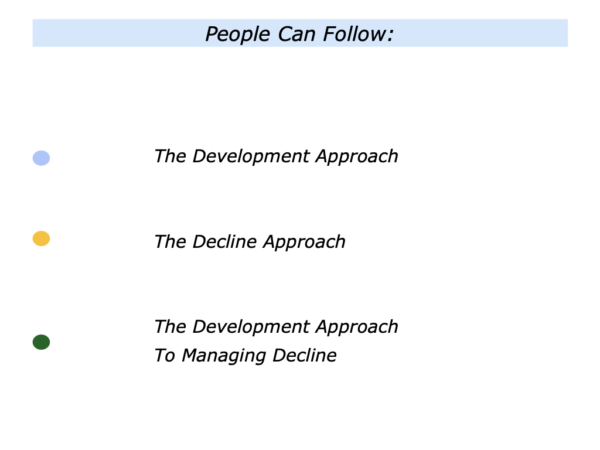
Some people continue to develop in their lives or work. Some people stop developing and find that things may decline. Some people take a development approach to managing things that may inevitably decline.
Different people follow these paths in different ways. Let’s explore how they translate these into action.
The Development Approach
There are many models for continue to develop. The following section describes some exercises that people can use in their lives and work. These involve a person needing:
To be honest with themselves … To be good at reading reality … To be prepared to develop.
You will have your own approach to taking these steps. If appropriate, however, you may want to adapt some of these exercises in your own way.
The Strengths Approach
To Development
Imagine you are looking to develop in the future. This approach involves building on your strengths whilst also tackling area for improvement. If you wish, try tackling the exercise on this theme.
Strengths
Looking at your life and work, what are the things you do well? What are the specific activities in which you deliver As rather than Bs or Cs? When do you feel in your element – at ease and yet able to excel?
What are the things you feel passionately about where you have the ability to perform superb work? What are the activities where you have a track record of delivering the goods? How can you build on these strengths?
Improvement
What are the areas where you can improve? How can you take steps to improve in these areas? Alternatively, how can you get help that will enable you to produce better results in these areas?
People often develop by building on their strengths and tackling a few areas for improvement. They can then continue to do good work and also deliver better results. Let’s explore how this works in action.
Development In Action
Dave, a sales director, performed brilliantly in certain activities. Recognised as a thought leader in his field, he was good at showing how his company could help certain kinds of clients to achieve success.
He was good at ‘capturing the beachhead’, closing the sale and keeping in touch with clients on a strategic level. But he was not great at implementing the day-to-day activities required to deliver all the goals.
Dave was also a good leader of people who demonstrated certain characteristics. They needed to have a ‘can do’ attitude and be resilient. They also needed to be resourceful in order to achieve the desired results.
He was not good, however, at managing a large team where some people may not show such characteristics. He had spent a lot of time managing such people, but this had taken him away from the activities that he did best. Bearing this in mind, we focused on the following themes.
Dave could build on his strengths on the sales front. He could spend more time closing sales and maintaining the strategic relationships with certain clients. This would bring benefits for the company.
When making the sale, at some point he could also hand over the implementation part to a mission holder. They could then manage the daily activities that helped the client to achieve success.
Dave could be a good leader of a small leadership team. He was good at providing inspiring visions and supporting people who demonstrated certain characteristics.
Looking ahead, he would behave in a caring and professional way to everybody in the sales organisation. He needed to have good coordinators, however, who could then manage the wider team.
Dave could also build on his ability as a thought leader. One approach could be to make videos where Dave was interviewed about future trends in the company’s chosen field. These would reach a wider audience and could lead to future sales.
Let’s return to your own life and work. Here is the exercise on the theme of building on your strengths and tackling areas for improvement. If you wish, try completing the following sentences.
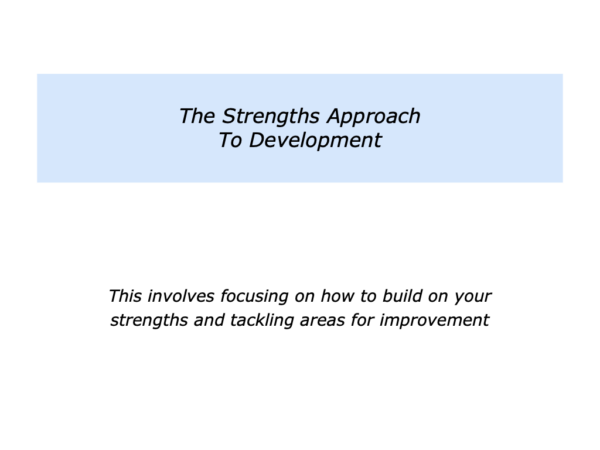
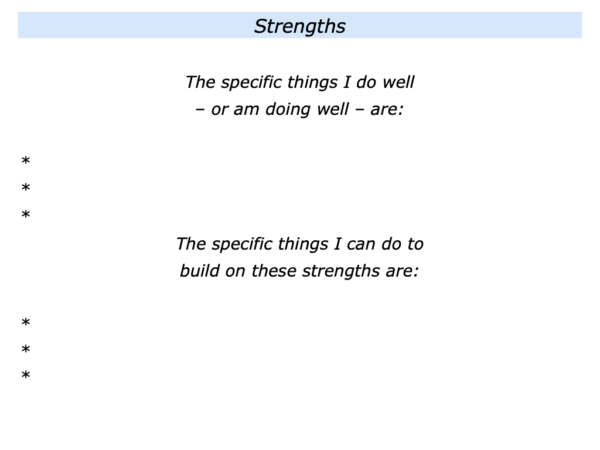
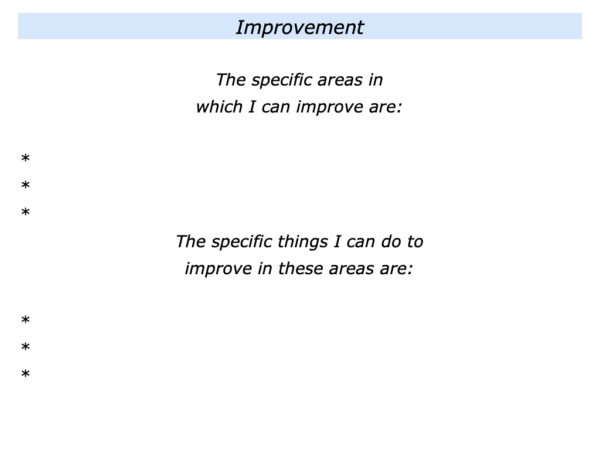
The Green, Amber, Red And Blue
Zones Approach To Development
This approach involves looking at your life and clarifying the things that are in the green, amber and red zones. It is also to explore the blue zone which involves focusing on future opportunities.
You can clarify how things are going regarding your health, relationships, work or other areas. If you wish, you can then act on this information and continue to shape your future. Let’s explore these steps.
The Green Zone
What are the specific things that are going well in your personal or professional life? How can you build on these things? What will be the benefits – both for yourself and other people?
You may be enjoying time with your children, encouraging your partner or doing other stimulating activities. You may be doing satisfying work, passing on knowledge or continuing to develop your skills.
Positive people often build on what is working. They keep nurturing these seeds to the benefit of both themselves and other people. Later we will explore how you can do this in your own way.
The Amber Zone
What are the specific things where there may be warning signs? You may detect such signs in your health, some relationships, financial matters or aspects of your work.
How can you improve these issues? How can you maybe move some into the green zone? How can you fix some of these before they move into the red zone? What will be the benefits?
The Red Zone
Looking at your life, are there any things that are not going well? Are there any issues that are causing difficulties? Are there any recurring problems that create collateral damage for yourself or other people?
Sometimes it is possible to find solutions. Sometimes it is important to identify the issues and then make a decision about the possible routes forwards.
The Blue Zone
So far we have looked at the things in your life that are in the green, amber and red zones. If you wish, you can add another dimension.
This involves using your imagination. It invites you to explore the potential opportunities and other things you can do to keep developing. You may wish to consider some of the possible things you can do:
To build on your strengths … To do more of the specific activities that give you positive energy … To do satisfying work … To do stimulating projects.
To improve certain skills … To keep developing as a person and as a professional … To pass on your knowledge to people … To do other things.
If you wish, try tackling the exercise on this theme. Looking at your life, this invites you to focus on the things that may be in the particular zones. If appropriate, you can then aim to take action in these areas. Here is the exercise.
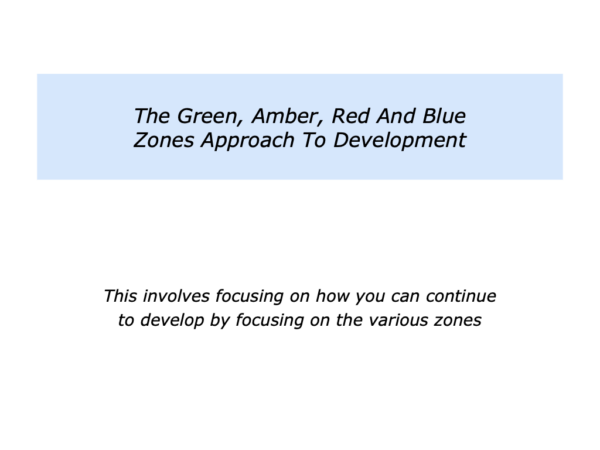
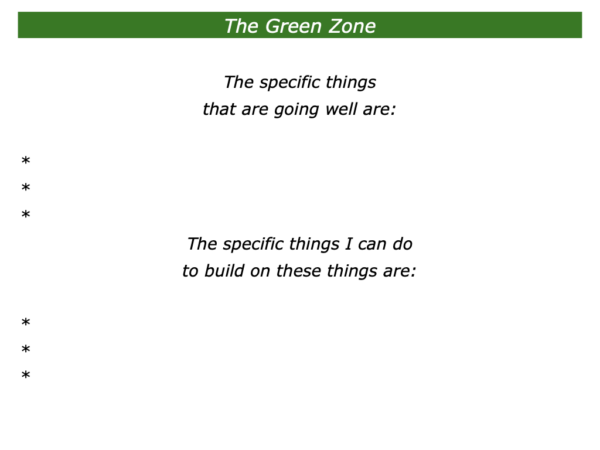
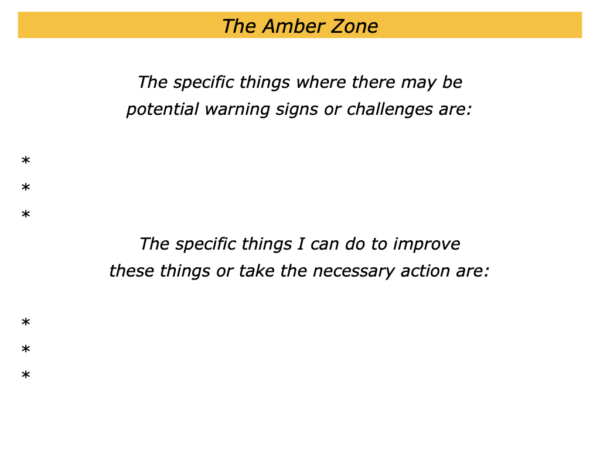
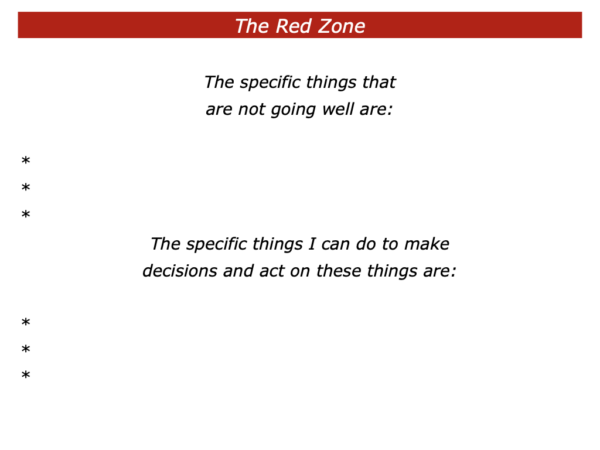
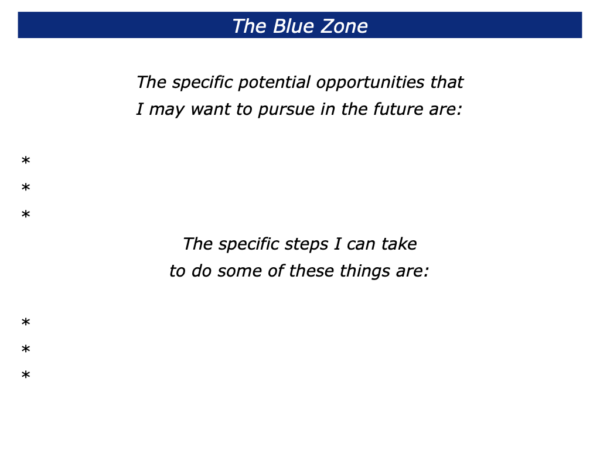
The Professional Goals Approach
This approach involves focusing on your long-term professional goals. Imagine that you are looking back at the end of your career. What do you want to have done or achieved by then? Here are some answers that individuals give.
The specific things I want to have done
or achieved by the end of my career are:
To have always followed my principles … To have done satisfying work that has helped people … To have built an ethical business … To have created positive cultures in which people have thrived … To have passed on my knowledge.
Imagine you have described what you want to achieve. What are the specific things you can do to work towards achieving them? What will be the benefits of achieving your professional goals – both for yourself and other people? Here is the exercise on these themes.
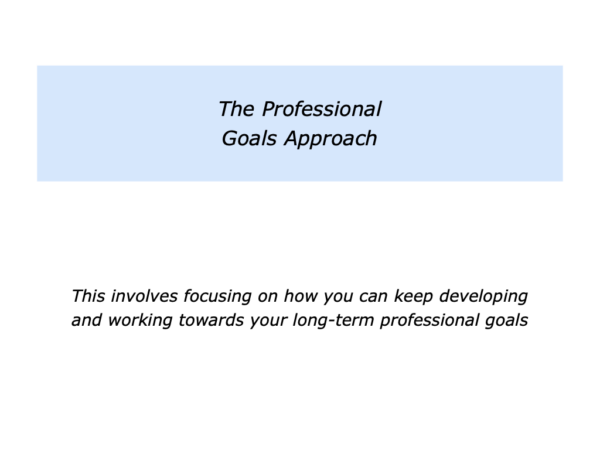
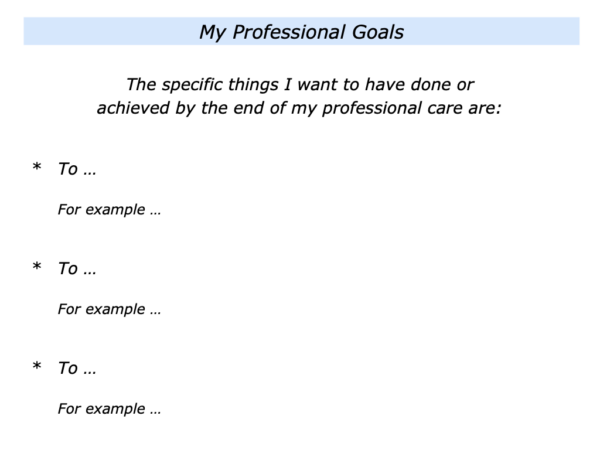
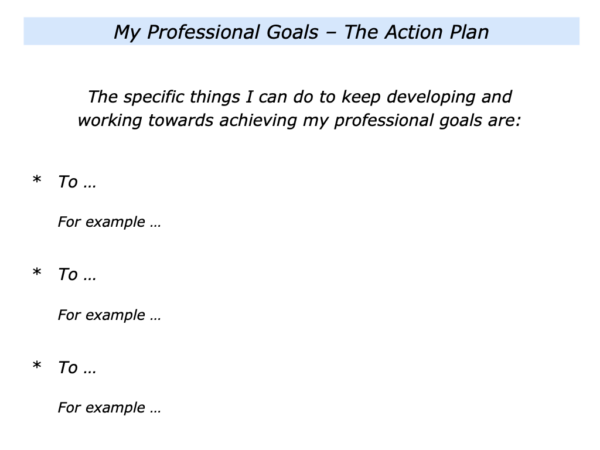
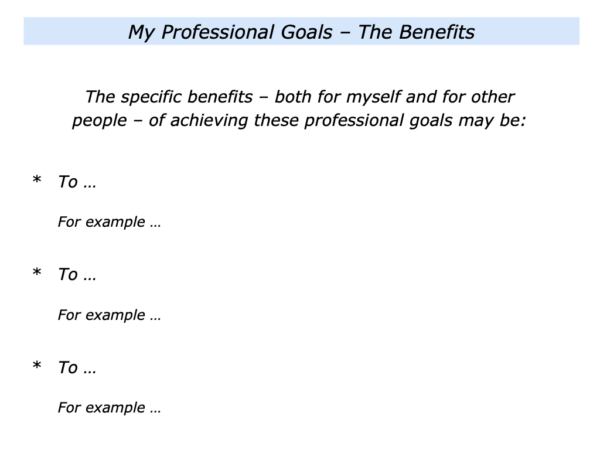
Many people choose to continue developing in their personal and professional lives. Different people follow this approach in different ways.
Some individuals build on their strengths and tackle areas for improvement. Some read reality and focus on issues that are in the various zones. Some keep working towards their long-term goals.
Some individuals follow this approach a fairly contented way. They count their blessings, appreciate life and aim to keep developing. Some embody the Japanese concept of Kaizen – continuous improvement.
Some individuals aim to become the best they can be. They aim to channel their personality rather than change their personality. They then aim to do their best during their time on the planet.
Let’s look at another approach that is sometimes taken by people, teams and organisations.
The Decline Approach
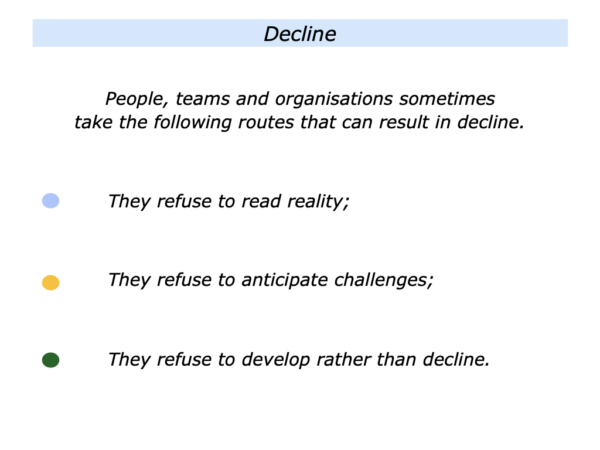
There are many reasons why things decline. Sometimes this is inevitable and a function of age. There are situations, however, where it is possible to develop rather than decline.
People, teams and organisations sometimes refuse to take this opportunity. The following sections explores some reasons why they continue to decline.
They Refuse To Read Reality
Some people choose to stay in denial. They refuse to read reality and see what is happening. Different people do this in different situations.
Some individuals do this with their health. They may choose not to heed warning signs or not go for regular medical checks. Some may say they do not want to know what is happening with their bodies.
Some organisations do this regarding morale in their work place. They may deny that employees are being abused. Some may actually stand by the abusers. This can have consequences for both the employees and the organisation.
They Refuse To
Anticipate Challenges
Some individuals refuse to focus on potential changes and challenges. They may become institutionalised and fail to take charge of shaping their career. They may instead hope that something turns up in the future.
Some organisations refuse to anticipate innovations or changes in their market. They may stick with out-dated ways of working or of treating their employees. This can lead to them falling behind in their chosen field.
They Refuse To Develop
Rather Than Decline
Some individuals refuse to develop a healthy lifestyle that can help themselves and, as a by-product, may help their loved ones. That is their choice, of course, but it can have consequences.
Some organisations refuse to develop new ways of providing service and helping their customers to succeed. They prefer not to study best new practice and apply the lessons in their own work. This can lead to them becoming obsolete.
As mentioned earlier, it is inevitable that some things decline. Bearing this in mind, however, some people focus on the following approach.
The Development Approach
To Managing Decline
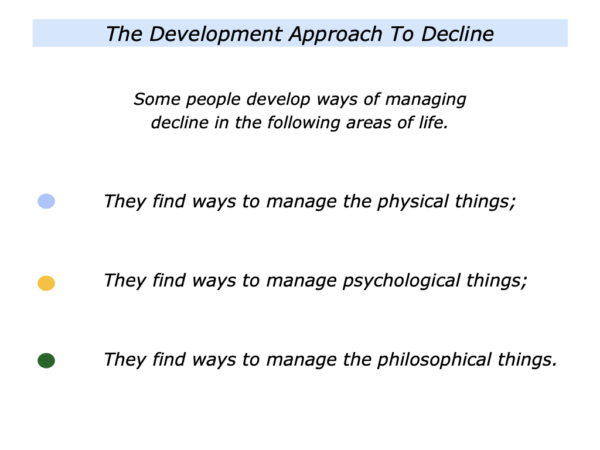
Some people develop ways to manage potential decline in different areas of life. Different people do this in different ways but there is one common factor:
They focus on what they can do rather than what they can’t do.
The following section looks at how some do this by taking the following steps.
They Find Ways To Manage
The Physical Things
Some people find ways to adapt as they age physically. They may walk with a stick, take naps and eat nutritious food that is suited to their condition. They may take up new activities to keep themselves fit.
Some people found new ways of doing things during Covid. If appropriate, they then continued to do some work from home rather than commute five days a week. They also developed the habit of home deliveries for their food.
Some use their brain to find new ways of pursuing hobbies or doing tasks where they had previously used brute force. It can take time to find such solutions but doing so can be satisfying.
They Find Ways To Manage
The Psychological Things
Some individuals feel more able to be themselves. They focus on what they can control rather than what they can’t control. They also follow the famous U-Bend – or Smile Illustration – that shows how many people get happier as they get older.
Some people simply vow to enjoy life. They dress how they want, play the music they want and spend time with the people they want. They aim to be the best they can be rather than compare themselves to other people.
Some learn to be fully present and enjoy each moment. Younger people may work towards goals that they believe will give them happiness in the future. Aware of their own mortality, older people may see each day as a bonus.
They Find Ways To Manage
The Philosophical Things
Some people follow their philosophy as they get older. They may aim to be true to their values, pursue a spiritual faith or follow their vocation. They then aim to translate this into daily action.
Some focus on a having sense of purpose. They may aim to care for their loved ones, pursue their chosen craft, pass on knowledge or do other activities that being meaning to their life.
Some people have a sense of perspective. Looking back, they are thankful for what they have been given in life. Looking ahead, they do their best to plant seeds of hope for future generations.
There are many ways to live life. Some people continue to develop. Some people stop developing and find that things may decline. Some people take a development approach to managing things that may inevitably decline.
Looking ahead, can you think of a specific situation where you want to follow elements of the development approach? How can you do this in your own way?
If you wish, try tackling the exercise on this theme. This invites you to complete the following sentences.
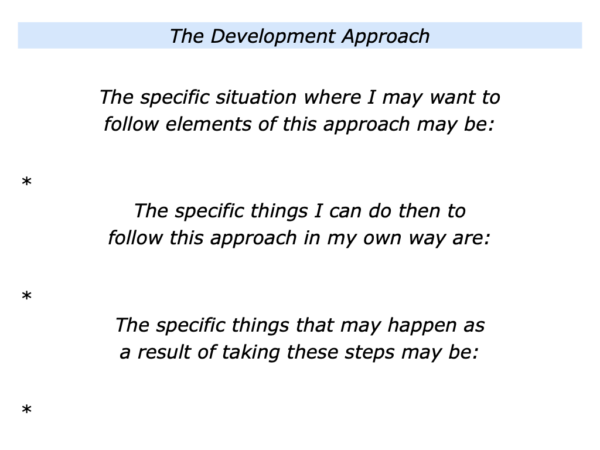






Leave a Reply